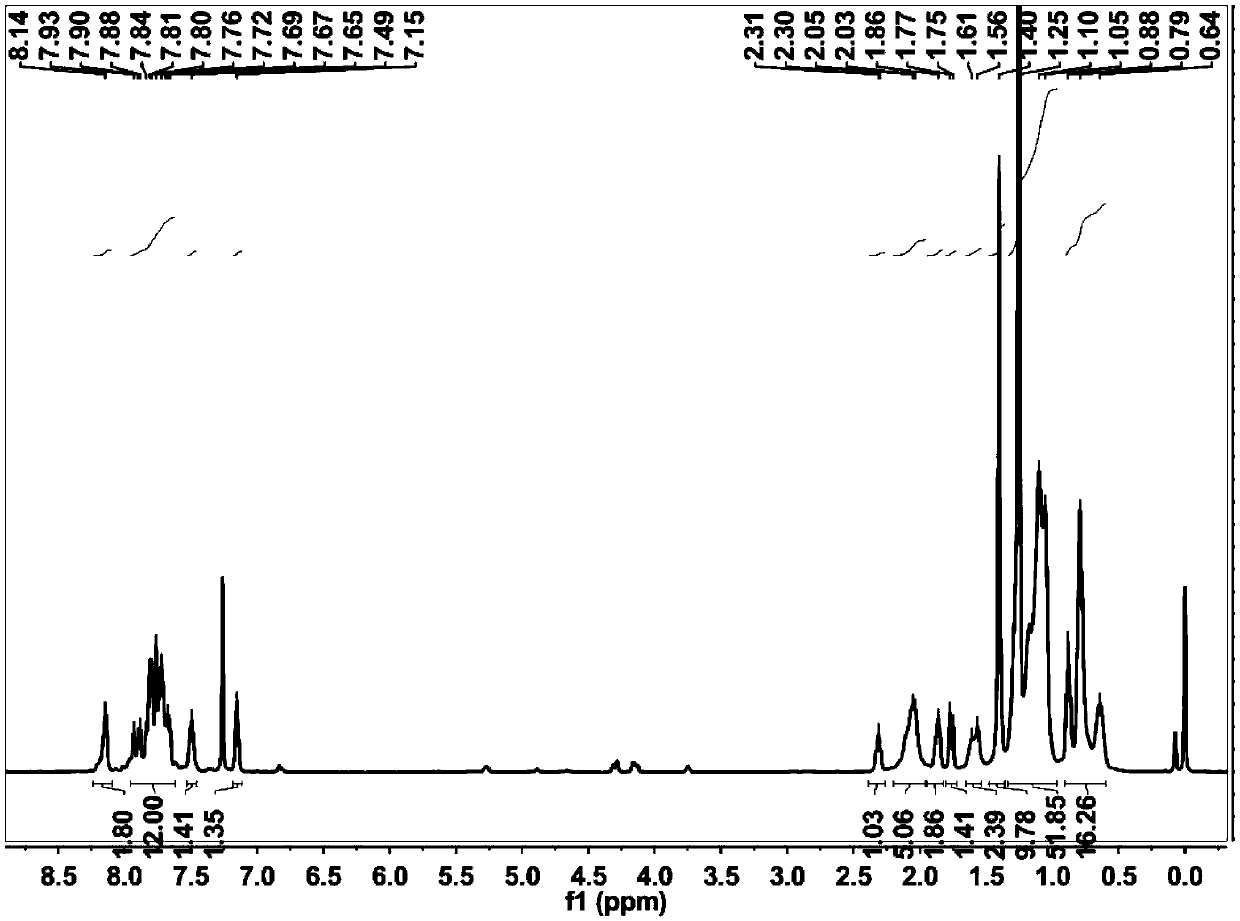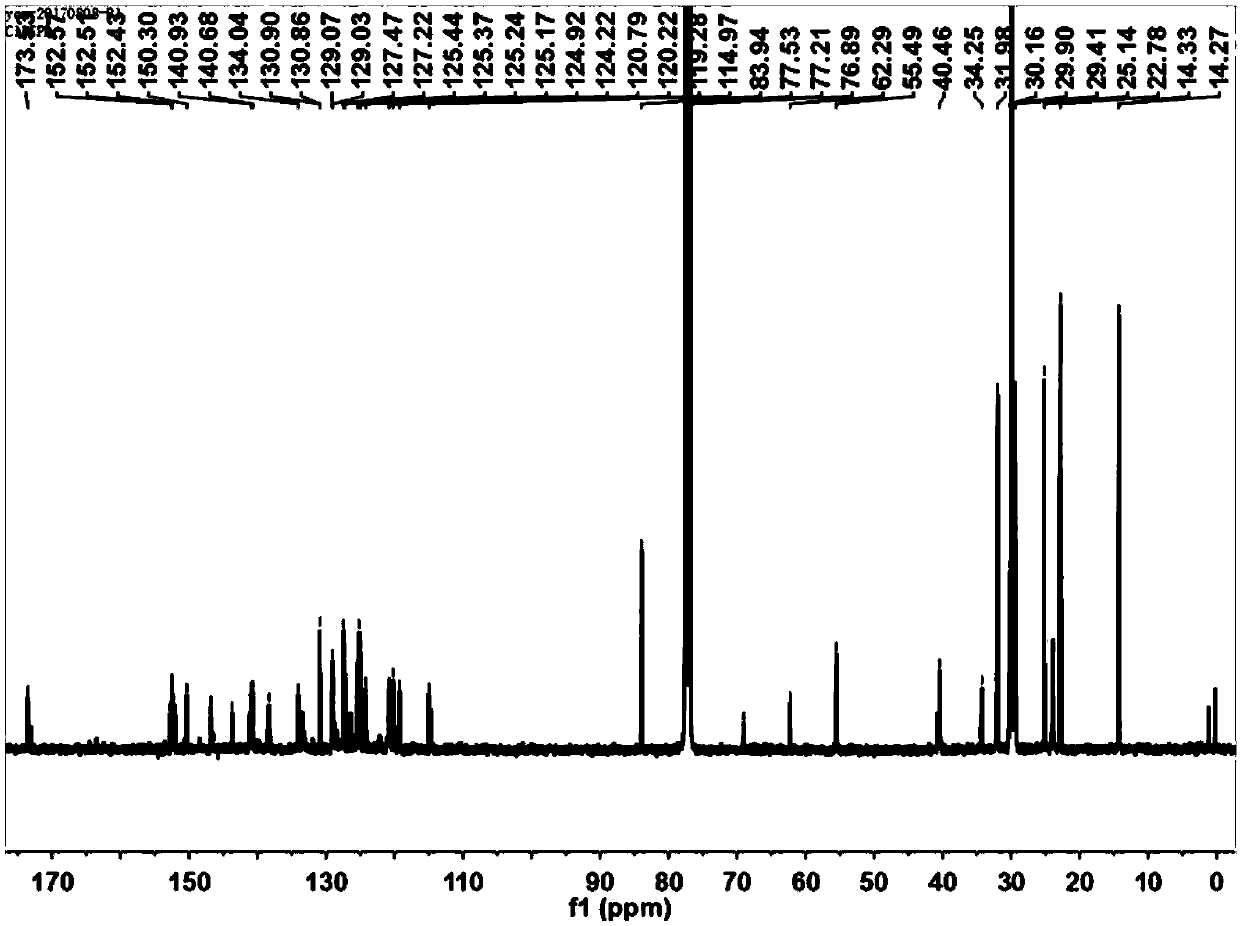High-fluorescence quantum efficiency red-light polymer, quantum dot solution and application
A quantum dot solution, fluorescent quantum technology, applied in the direction of fluorescence/phosphorescence, measuring devices, material analysis through optical means, etc., can solve the problems of complex design process, difficult synthesis and preparation, etc., and achieve little effect on cell activity and good biophase capacitive effect
- Summary
- Abstract
- Description
- Claims
- Application Information
AI Technical Summary
Problems solved by technology
Method used
Image
Examples
Embodiment 1
[0032] A method for preparing a red photopolymer with high fluorescent quantum efficiency, comprising the steps of:
[0033] 1. Preparation steps of monomer M1:
[0034] (1) A1 (2g, 6.8mmol), thiophene borate (3.57g, 17mmol), NaHCO 3 (5.72g, 68mmol), tris(dibenzylideneacetone)dipalladium (0.31g, 0.34mmol), tris(o-methylphenyl)phosphine (0.41g, 1.36mmol) were added to tetrahydrofuran (80mL) and water ( 30mL) of the mixed solution, repeated degassing, in N 2 Under the atmosphere, the temperature was raised to 90°C for 72h.
[0035] The reaction solution was cooled to room temperature, extracted with chloroform and saturated brine, the organic phase was collected, dried by adding anhydrous magnesium sulfate, and the solvent was spin-dried. After passing through a silica gel column, the crude product was recrystallized from a mixed solvent of dichloromethane and petroleum ether to obtain an orange-red solid B1 (1.2 g, 60%).
[0036] (2) Add B1 (130mg, 0.43mmol) and N-bromosucc...
Embodiment 2
[0060] A red photopolymer quantum dot solution with high fluorescent quantum efficiency is prepared by the following method: the red photopolymer with high fluorescent quantum efficiency shown in formula I is dissolved in tetrahydrofuran to form a solution with a concentration of 0.5mg / mL The solution is solution one; polystyrene-maleic anhydride with a number average molecular weight of 1.7kg / mol is dissolved in tetrahydrofuran to make a solution with a concentration of 0.5mg / mL as solution two; the volume ratio is 5:1 Ratio, mix solution 1 and solution 2 to obtain a precursor solution, inject the precursor solution into deionized water with a volume ratio of 3:10 under ultrasonic conditions; ), at N 2 Heated to 90°C under protection (the experiment proved that the temperature can be 90-95°C), evaporated to remove tetrahydrofuran, and stopped N 2 , stop heating, lower to room temperature, pass through a 220nm water filter head, and the filtrate is a red photopolymer quantum ...
Embodiment 3
[0065] Biosynthesis of Red Photopolymer Quantum Dots with High Fluorescence Quantum Efficiency.
[0066] Add 20 μL of 5% weight / volume polyethylene glycol aqueous solution (weight average molecular weight = 3.35 kg / mol) and 20 μL of HEPES (hydroxyethylpiperazine ethylsulfuric acid) buffer (1 M, pH = 7.2) to 1 mL Streptavidin (1 mg / mL, 60 μL) was added to the 50 μg / mL aqueous solution of red photopolymer quantum dots with high fluorescence quantum efficiency, and mixed. Add 20 μL of freshly prepared EDC (1-ethyl 3-[3-dimethylaminopropyl]carbodiimide hydrochloride) solution (5 mg / mL in Milli-Q water), mix, and dissolve the above mixture Stir at room temperature for 4 hours. Centrifuge with an ultrafiltration centrifuge tube (molecular weight cut-off = 100,000) to obtain streptavidin-biochemical red photopolymer quantum dots.
PUM
| Property | Measurement | Unit |
|---|---|---|
| particle diameter | aaaaa | aaaaa |
| particle size | aaaaa | aaaaa |
Abstract
Description
Claims
Application Information
 Login to View More
Login to View More - R&D
- Intellectual Property
- Life Sciences
- Materials
- Tech Scout
- Unparalleled Data Quality
- Higher Quality Content
- 60% Fewer Hallucinations
Browse by: Latest US Patents, China's latest patents, Technical Efficacy Thesaurus, Application Domain, Technology Topic, Popular Technical Reports.
© 2025 PatSnap. All rights reserved.Legal|Privacy policy|Modern Slavery Act Transparency Statement|Sitemap|About US| Contact US: help@patsnap.com



